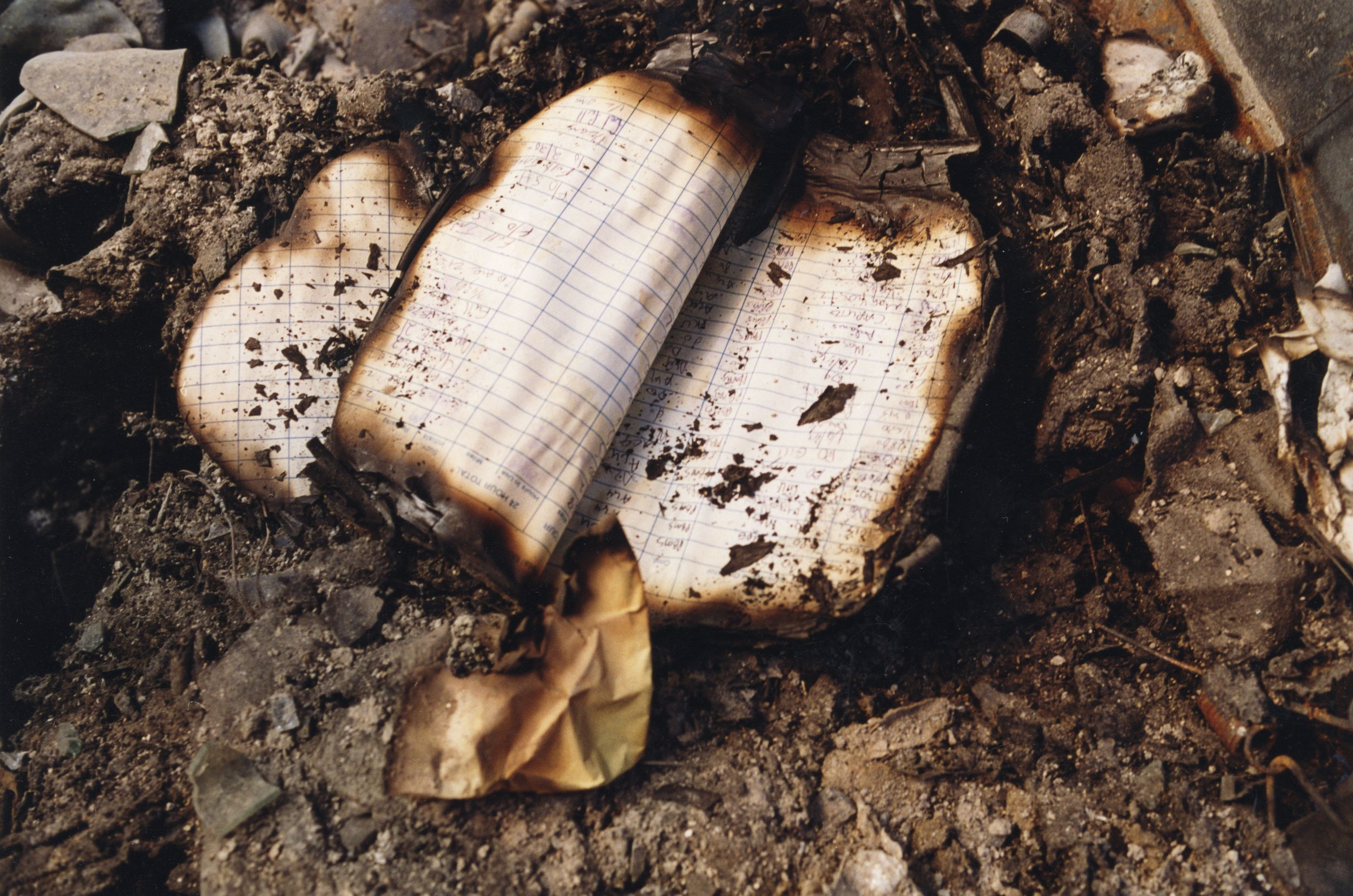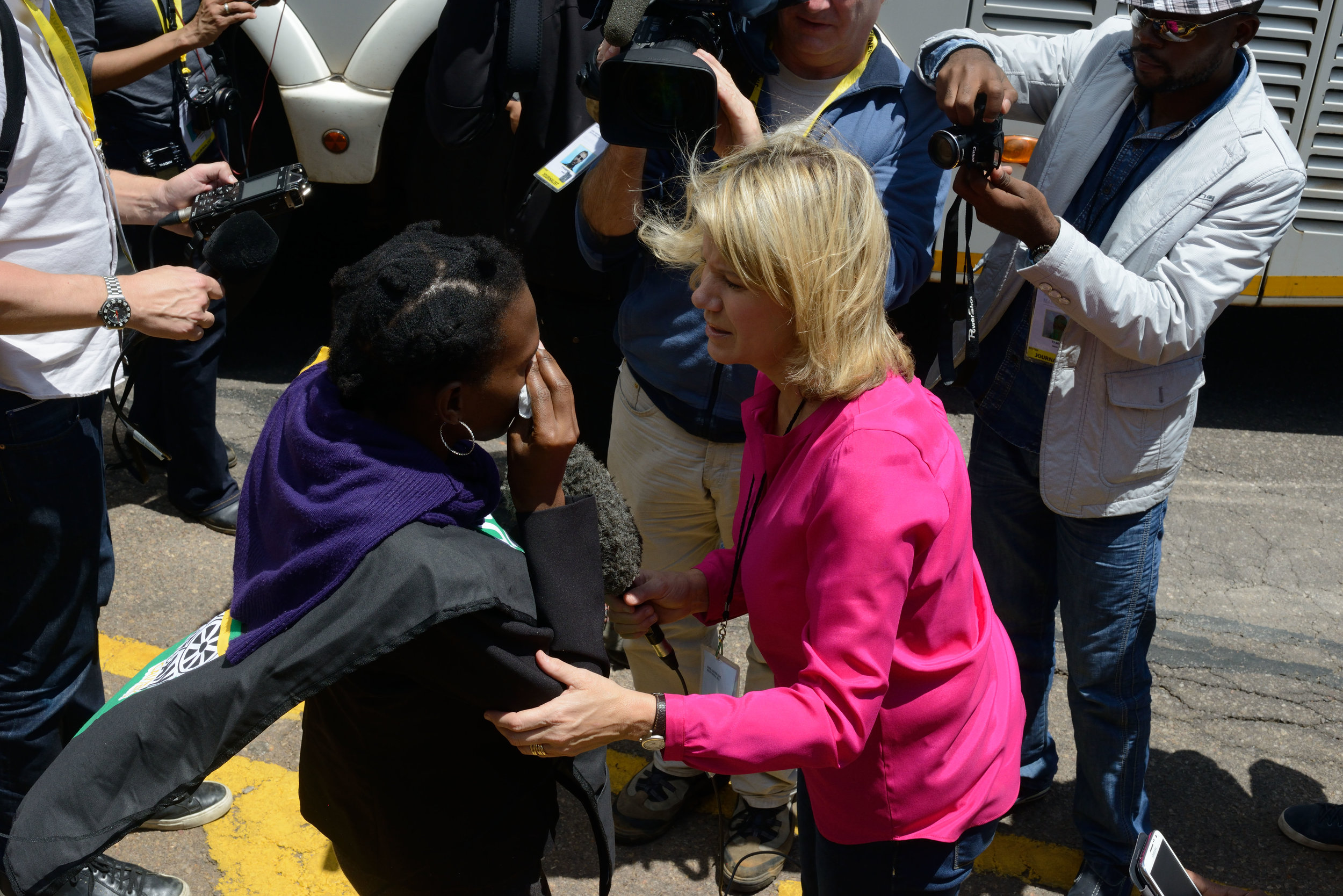An anchorwoman interviewing a mourner who has just viewed the body of Nelson Mandela lying in state, Pretoria, South Africa
An anchorwoman interviewing a mourner who has just viewed the body of Nelson Mandela lying in state, Pretoria, South Africa
At the Rivonia Trial, in which he and his comrades were sentenced to life in prison on Robben Island for committing high treason, Nelson Mandela defiantly claimed, “I have cherished the ideal of a democratic and free society in which all persons live together in harmony and with equal opportunities. It is an ideal, which I hope to live for and to achieve. But if needs be, it is an ideal for which I am prepared to die.”
Born into a royal family of the Thembu tribe, Mandela spent his boyhood herding sheep and goats. He lived to become the first black president of South Africa, a Nobel Prize winner, and a deeply revered figure throughout the world.
When Mandela visited the United States in 2008 he was required to obtain special State Department clearance because his name remained on the U.S. Terrorism watchlist.
Nelson Mandela and the African National Congress, History,
https://www.history.com/topics/nelson-mandela
After the 1948 election of the Afrikaner-Dominated National Party , which introduced the apartheid, Nelson Mandela’s popularity as an ant-apartheid and peace leader grew immensely. In 1952 Madela helped to lead the African National Congress’ a Campaign for the Defiance of Unjust Laws. During this time they traveled across the country to protest the apartheid and promote the Freedom Charter (which was ratified by the Congress of the People in 1955).
On December 5th, 1956 Madela was arrested, along with 155 other activists, for treason. Although they were all acquitted, tensions with the ANC had escalated greatly. In 1959 a faction of the ANC broke off to form the militant group “Pan Africanist Congress” (PAC). The following year the police shot and 69 black peaceful protesters, prompting the ANC and PAC to have to exist undercover and for Madela to consider more drastic approaches to protesting. He the formed the armed section of the ANC called the Umkhonto we Sizwe (“Spear of the Nation”), this would be the organization which his involvement in would put him in jail for nearly 3 decades.
Mandela is quoted saying “[I]t would be wrong and unrealistic for African leaders to continue preaching peace and nonviolence at a time when the government met our peaceful demands with force. It was only when all else had failed, when all channels of peaceful protest had been barred to us, that the decision was made to embark on violent forms of political struggle.”
Gambrell, Jon, and Clendenning, Alan, Nelson Mandela Memorial Draws Mourners and World Leaders to South Africa’s Soweto Stadium, The Huffington Post, 10 December 2013.
http://www.huffingtonpost.ca/2013/12/10/nelson-mandela-memorial-canada_n_4417219.html
In this article Gambrell and Clendenning describe the public memorial of South African leader Nelson Mandela in December of 2013. The memorial was held in a soccer stadium in Soweto “the Johannesburg township that was a stronghold of support for the anti-apartheid struggle that Mandela embodied.” Despite rain the memorial drew roughly 50,000 mourners including a “dazzling mix of royalty, statesmen and celebrities.”
The mood was celebratory as spectators “sang praise for Mandela” who is “seen by many South Africans as the father of the nation.” Gambrell and Clendenning report “sounds of horns and cheering” throughout the stadium accompanied by the sounds of vuvuzelas and “songs from the era of the anti-apartheid struggle.”
Those in attendance included President of the United States Barack Obama, French President Francois Hollande, United Nations Secretary-General Ban Ki-moon, actress Charlize Theron, model Naomi Campbell, and many more figures of note.
Some, like driver Harry Tshabalala, even saw the rain as celebratory, saying “In our culture the rain is a blessing...Only great, great people are memorialized with it. Rain is life. This is perfect weather for us on this occasion."
The article quotes graduate student Matlhogonolo Mothoagae expressing personal gratitude to Mandela saying "I would not have the life I have today if it was not for him...He was jailed so we could have our freedom.”
Dewey, Caitlin, Why Nelson Mandela Was on a Terrorism Watch List in 2008, The Washington Post, 7 December 2013.
https://www.washingtonpost.com/news/the-fix/wp/2013/12/07/why-nelson-mandela-was-on-a-terrorism-watch-list-in-2008/?utm_term=.49acf66a3407
In this article Dewey explains Nelson Mandela’s complicated relationship with the West within the context of his death and globally attended and televised memorial. She explains that, while the world at large praises and remembers Mandela after his death “for his heroic, life-long battle against apartheid and injustice in South Africa” the Western world and the United States specifically have not consistently advocated this point of view. Dewey reports that “as late as 2008, the Nobel Prize winner and former president was still on the U.S. terrorism watch list.”
The source of American distrust of Nelson Mandela came from a continued fear of communism. In the 1980s while Mandela was imprisoned, many world leaders began to advocate for his release. However the Reagan administration “still saw communism as one of its primary enemies -- and defeating communism as one of its foremost foreign policy goals.” This sentiment “complicated the administration’s take on South Africa.”
Apartheid had supported US anti-communist efforts in the Cold War and throughout the Nixon and Reagan administrations “to limit Soviet influence in the region” while the African National Congress (the political party which Mandela was chairman) was “peppered with members of the South African Communist Party.”
The African National Congress (ANC) was deemed too friendly with Moscow after the Secretary General of the party, Alfred Nzo, “bore greetings to the Soviet communist party congress in 1986.” In response, President Reagan publicly accused the ANC of communism and pledged not to assist or negotiate with the group. The British Government, led by Margaret Thatcher, echoed these sentiments. Dewey points out that both the U.S. and U.K. were “major South African trade partner[s]” during the Apartheid Regime.
Dewey explains that while the official position of the United States government was to end Apartheid and secure the release of Nelson Mandela the “U.S. dragged its feet on the crucial issue of economic sanctions. When a United Nations resolution came up that criticized apartheid, both the U.S. and Britain pushed through amendments to weaken it.” The Reagan administration had also designated the ANC a terrorist group in the 1970s, which required Mandela “to get special State Department clearance to enter the U.S. in 2008.” Then Secretary of State Condoleezza Rice called the situation “a rather embarrassing matter.”
Although the U.S. eventually enforced sanctions which “are widely credited for helping topple...the apartheid regime” the delay in action is still criticized by South Africans including Mandela’s wife, Winnie. She once said of the Reagan administration “It appears their interests in this country far outweighs their so-called abhorrence of apartheid.”














































